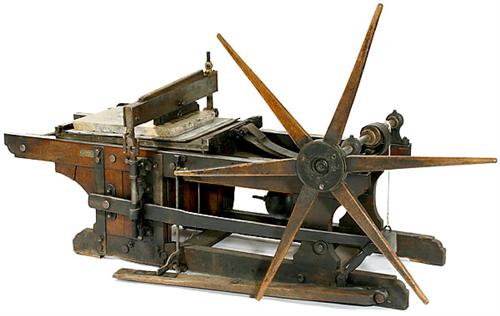History of manually driven lithographic presses
|
|

|
|
Alois Senefelder invented lithography in Bavaria, around 1790 |
|

|
|
First he tried to print the stones on an etching press. After all, besides the typographic press ("Gutenberg"), the etching press was the only alternative. This failed because the stones were not sufficiently flat. If the stone is sphere, concave, or obliquely cut, they will break under pressure. That is why Senefelder developed the "gallows press". Made entirely of wood and the scraper was able to follow every "curved" surface of the stone due to the flexibility in the wooden construction. |
|

|
|
Senefelder's gallow-press |
|
Based on Senefelders ideas presses were developed further. Like the wooden presses in France. A well known brand was Voirin. |
|

|
|
Properties of these French presses:
- Because of the wooden construction very suitable to print from "less perfect stones".
- Cultural value; the famous prints of Toulouse Lautres were printed on these presses.
- The artist can change the scraper pressure by changing his standing position on the long plank.
- The press has a top pressure system.
- Moving the bed is easy and comfortable by means of a big woorden spoke wheel.
|
|

|
|
A Krause lithographic press. Properties:
- The presses are heavy.
- Top pressure system by means of a lever and knee-joint system
- The "callf" (the top part) is suspended "floating" (by leather piles) to give it flexability, to avoid broken stones.
- Driven by a crank and gear wheel. Can be disconnected for a quick pull back of the bed.
|
|

|
|
An English-American hand press. Properties:
- Lighter cast iron construction than the German presses
- Under pressure system by means of a special lever
- Driven by a crank, without gear box, by means of a long arm
- Presses were mostly equipped with tympan and frisket to keep the paper in place.
- The construction was less flexible than the German and French presses, hence more risk of broken stones.
|
|
Some general remarks:
- Lithostones are nowadays much more accurate than in the past. Less risk of broken stones.
- The lithopresses were especially developed for printing from stones. Nowadays there are more possibilities to print from: aluminium plates, zinc plates, polyester etc. There is no reason to use a lithopress for these new media, an etching press will do fine.
|
|
|
|
| |